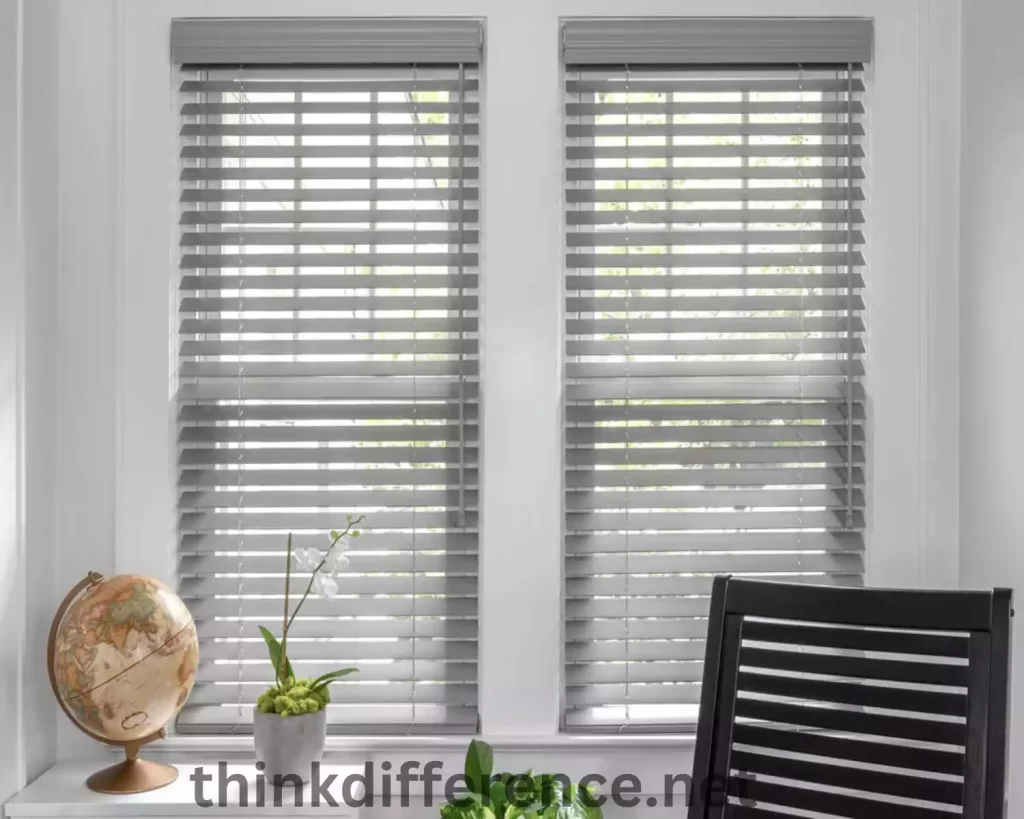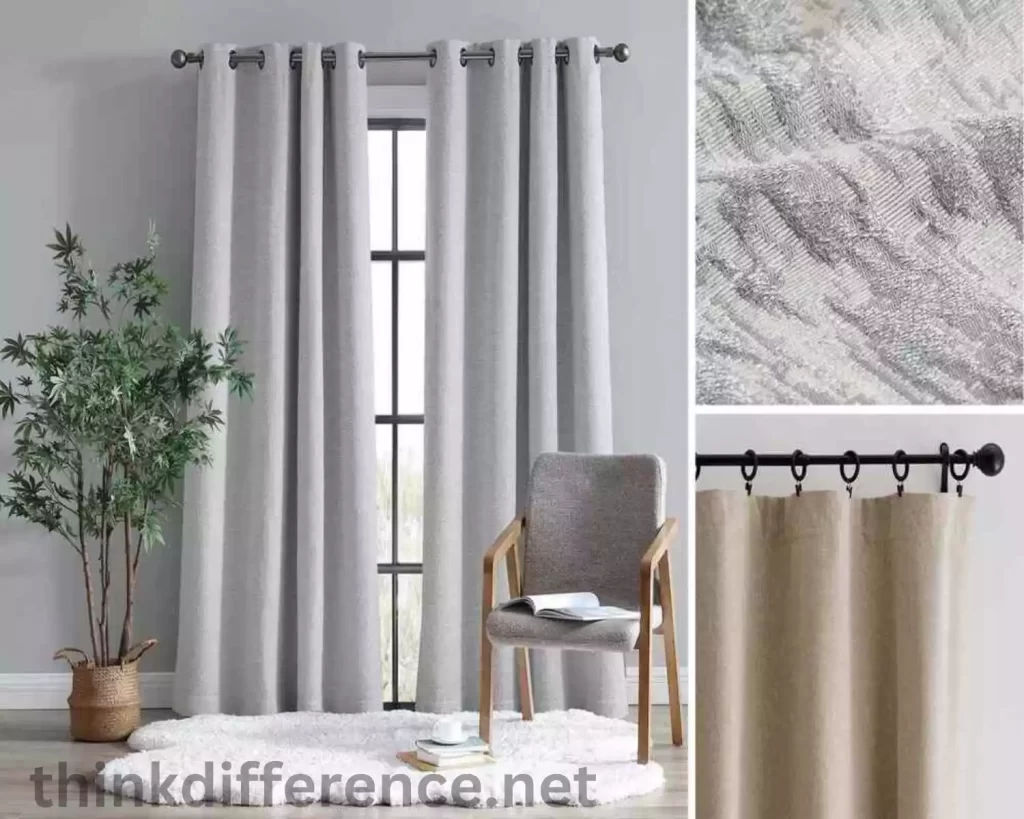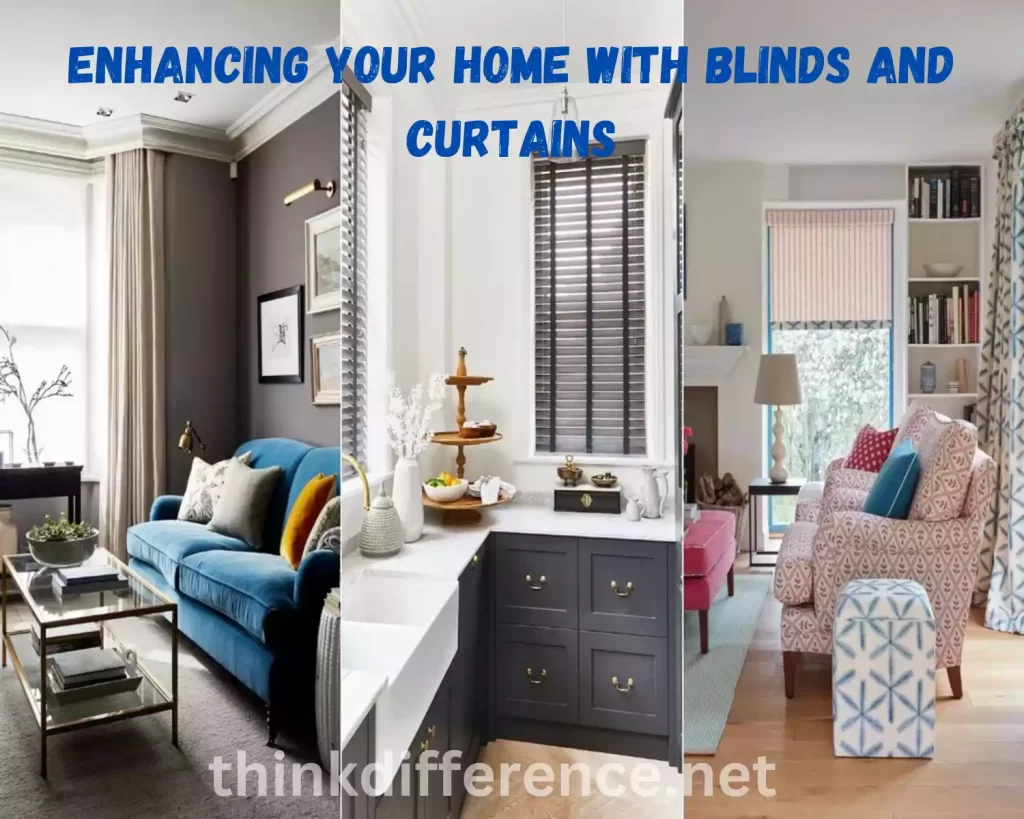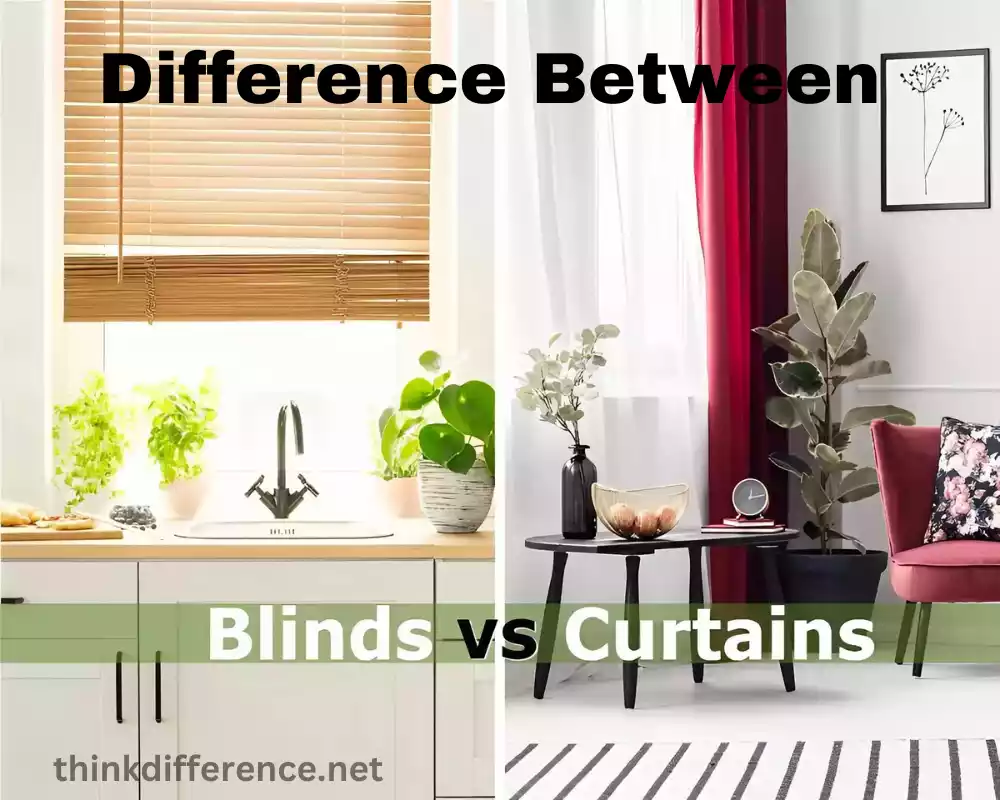Blinds and curtains are two popular window treatments used in homes. While both serve similar purposes, they differ in their design and functionality. Blinds are made up of individual slats or vanes that can be adjusted to control the amount of light and privacy. On the other hand, curtains are fabric panels that are typically hung from a rod or track and can be opened or closed.
Definition of Blinds and Curtains
Blinds:
Blinds are window coverings composed of horizontal or vertical panels or slats typically composed of wood, vinyl, aluminum or fabric material that can be adjusted in order to control sunlight entering a room and offer privacy.

Blinds provide users with an adjustable solution for light control and privacy issues as they allow users to alter the amount of sun entering through while providing privacy from prying eyes outside. There are various styles of blinds including Venetian vertical Roman roller and panel blinds each offering distinct designs and features for light regulation or control needs.
Curtains:
Curtains are fabric panels or draperies that hang from a rod or track to cover windows or doorways. They are primarily used for decorative purposes and can also provide light control and privacy to varying degrees. Curtains come in an assortment of fabrics, colors and patterns suited to suit various styles and tastes.

Polyester, cotton silk or linen materials may all be utilized when creating curtains for windows. Depending on the fabric and thickness, curtains can filter or block light, create ambiance, add texture to a room, and enhance its overall aesthetic appeal. Curtains are typically gathered or pleated at the top and can be opened or closed using a rod, rings, or hooks, providing versatility in adjusting the amount of light and privacy desired.
Types of Blinds
There are several types of Blinds available. Each offering unique features and functionalities. Here are some commonly used types of blinds:
- Venetian Blinds:
- Description: Venetian blinds consist of horizontal slats that are connected by strings or cords. They are one of the most popular and versatile types of blinds.
- Material: Venetian blinds can be made from various materials, including aluminum, wood, or faux wood.
- Operation: They can be tilted to control the amount of light entering the room and can also be raised or lowered.
- Benefits: Venetian blinds offer precise control over light and privacy. They are easy to clean, durable, and suitable for various room styles.
- Vertical Blinds:
- Description: Vertical blinds feature vertical slats that hang from a track. They are commonly used for covering large windows or sliding glass doors.
- Material: Vertical blinds are typically made of fabric, PVC, or vinyl.
- Operation: The slats can be rotated to control light and privacy, and the blinds can be easily drawn to the side for unobstructed views.
- Benefits: Vertical blinds provide effective light control and are suitable for wide windows or doors. They are easy to maintain and can withstand regular use.
- Roller Blinds:
- Description: Roller blinds consist of a single piece of fabric that rolls up onto a tube when not in use.
- Material: Roller blinds can be made from various materials, such as polyester, cotton, or sunscreen fabric.
- Operation: They can be manually operated by pulling a cord or chain, or motorized options are available for remote control operation.
- Benefits: Roller blinds offer a clean and contemporary look. They are easy to operate, provide varying levels of light filtration, and can be customized with different patterns and designs.
- Roman Blinds:
- Description: Roman blinds are made of fabric panels that fold up in evenly spaced horizontal pleats when raised.
- Material: Roman blinds are commonly made of soft fabrics like cotton, linen, or silk.
- Operation: They can be raised or lowered using a cord or chain mechanism.
- Benefits: Roman blinds add an elegant and sophisticated touch to a room. They provide excellent light control and can create a neat and uncluttered appearance when fully raised.
- Panel Blinds:
- Description: Panel blinds consist of large fabric panels that slide on a track system.
- Material: Panel blinds are usually made of fabric, including woven materials, screen fabrics, or natural materials like bamboo.
- Operation: The panels can be easily moved to one side or split in the middle for desired light and privacy control.
- Benefits: Panel blinds are suitable for covering wide windows, sliding doors, or as room dividers. They offer a contemporary look and can be customized with various fabric options.
These are just a few examples of the types of blinds available in the market. When choosing blinds, consider factors such as the room’s style, light control needs, and personal preferences to find the most suitable option for your space.
Types of Curtains
Curtains come in a variety of styles, Fabrics and designs. Allowing you to enhance the aesthetics of your space while fulfilling functional needs.
Here are some common types of curtains:
- Sheer Curtains:
- Description: Sheer curtains are made of lightweight and translucent fabrics that allow natural light to filter through while maintaining privacy.
- Material: Sheer curtains are typically made from materials like voile, chiffon, or lace.
- Benefits: Sheer curtains create an airy and delicate look in a room. They soften harsh sunlight, provide privacy during the day, and offer a sense of elegance and sophistication.
- Blackout Curtains:
- Description: Blackout curtains are designed to block out external light completely, creating a dark and cozy environment.
- Material: Blackout curtains are usually made of thicker and heavier fabrics with an added blackout lining, which provides light-blocking properties.
- Benefits: Blackout curtains are ideal for bedrooms, home theaters, or spaces where you need to control light levels. They help to reduce noise, improve insulation, and enhance privacy.
- Thermal Curtains:
- Description: Thermal curtains are designed to regulate temperature by insulating against heat and cold, helping to maintain a comfortable indoor environment.
- Material: Thermal curtains often consist of multiple layers, including a thermal lining or interlining.
- Benefits: Thermal curtains help to reduce energy consumption by minimizing heat loss during winter and heat gain during summer. They provide insulation against drafts and can contribute to energy efficiency.
- Valances:
- Description: Valances are decorative curtain toppers that are used to add a finishing touch to windows.
- Material: Valances can be made from a variety of materials, including fabric, lace, or even wood.
- Benefits: Valances enhance the aesthetic appeal of a window by adding a decorative element. They can be used alone or in combination with other curtain styles to create a layered look.
These are just a few examples of curtain types. Other options include pleated curtains, grommet curtains, tab-top curtains, and more. Additionally, curtains come in various lengths, from floor-length to café-style, allowing you to choose the appropriate style for your window and room design.
Consider factors such as light control, privacy, insulation needs, and the aesthetic of your space when selecting the type of curtains that best suit your requirements.
Differences between Blinds and Curtains
Blinds and curtains are both popular window coverings that offer various benefits and serve different purposes.
Here are some key differences between blinds and curtains:
- Design and Appearance:
- Blinds: Blinds are typically made of slats or panels that can be adjusted to control light and privacy. They have a sleek and structured appearance, offering a more modern and minimalist look.
- Curtains: Curtains are fabric panels that hang from a rod or track. They come in various designs, colors, patterns, and textures, allowing for more customization and the ability to enhance the overall decor style of a room.
- Functionality and Usage:
- Blinds: Blinds offer precise control over light and privacy. The slats or panels can be tilted, raised, or lowered to adjust the amount of light entering the room and to maintain privacy. They are ideal for rooms where light control and privacy are a priority, such as bedrooms or offices.
- Curtains: Curtains are primarily used for decorative purposes, although they also provide light control and privacy to some extent. They are often used in living rooms, dining areas, and formal spaces, where the emphasis is on enhancing the aesthetics of the room.
- Light Control and Privacy:
- Blinds: Blinds offer better control over light and privacy compared to curtains. The adjustable slats or panels allow you to regulate the amount of light entering the room and adjust privacy levels according to your preferences.
- Curtains: While curtains can partially block light, they usually don’t offer the same level of light control as blinds. Thicker and darker curtains, such as blackout curtains, can provide better light blocking and privacy, but they may not be as versatile in adjusting light levels as blinds.
- Maintenance and Cleaning:
- Blinds: Blinds are generally easier to clean and maintain. They can be wiped down with a damp cloth or dusted regularly to remove dirt and dust. Some blinds can be detached and soaked in water for a deeper cleaning.
- Curtains: Curtains typically require more effort when it comes to cleaning. They may need to be removed and laundered or sent for dry cleaning, depending on the fabric and size. Regular vacuuming can help to remove dust from curtains between washes.
- Cost Considerations:
- Blinds: Blinds come in a range of prices depending on the type of material, size, and brand. They can be more affordable compared to curtains, especially if you opt for basic materials like aluminum or vinyl.
- Curtains: The cost of curtains can vary significantly based on factors such as fabric quality, length, width, and design. Custom-made or high-end curtains tend to be more expensive than ready-made options. Additionally, the need for multiple panels to cover larger windows can increase the cost.
- Durability and Lifespan:
- Blinds: Blinds, particularly those made of durable materials like aluminum or wood, tend to be more resilient and have a longer lifespan. They can withstand regular use and exposure to sunlight without significant wear and tear.
- Curtains: The durability of curtains depends on the fabric quality and maintenance. Delicate fabrics may be prone to fading or damage over time, especially if they are exposed to direct sunlight. Well-made curtains with proper care can last for several years.
It’s important to consider your specific needs, preferences, and the characteristics of the room when choosing between blinds and curtains. Some homeowners choose to combine both options, using blinds for functional purposes and curtains for decorative appeal, creating a layered and versatile window covering solution.
Factors to Consider When Choosing Blinds and Curtains
When choosing between Blinds and Curtains for your windows, several factors should be taken into consideration to ensure you make the right choice. Take into consideration these key points:
- Style and Décor Preferences:
- Consider the overall style and décor of your room. Decide whether you want the window coverings to blend in seamlessly or make a statement as a focal point.
- Light Control and Privacy:
- Determine the level of light control and privacy you need. If you require precise control over light entering the room and maintaining privacy, blinds may be a better option. If you prioritize diffusing light and maintaining some privacy, curtains could be a suitable choice.
- Energy Efficiency:
- Evaluate the energy efficiency needs of your space. Certain blinds and curtains, such as thermal curtains or blinds with insulating features, can help regulate temperature, reduce heat transfer, and contribute to energy savings.
- Budget Constraints:
- Determine your budget for window coverings. Blinds and curtains come in a range of prices, and the cost can vary based on factors such as materials, size, customization, and brand.
- Window Size and Type:
- Consider the size, shape, and type of windows you have. Some window coverings may be more suitable for specific window types, such as large windows, sliding doors, or arched windows.
- Maintenance and Cleaning:
- Assess the level of maintenance and cleaning required for the window coverings. Blinds are generally easier to clean and maintain, while curtains may require more frequent washing or dry cleaning.
- Durability and Lifespan:
- Evaluate the durability and expected lifespan of the window coverings. Some materials, such as wood or aluminum blinds, tend to be more durable and have a longer lifespan compared to delicate curtain fabrics.
- Personal Preferences:
- Consider your personal preferences and lifestyle. Think about factors such as preferred colors, patterns, textures, and any specific requirements you may have, such as child safety features or ease of operation.
- Room Functionality:
- Take into account the specific functionality and purpose of the room. For example, bedrooms may require blackout curtains for better sleep, while kitchens or bathrooms may benefit from blinds that are moisture-resistant and easy to clean.
- Combination Options:
- Explore the possibility of combining blinds and curtains for enhanced functionality and aesthetics. Layering blinds with curtains can provide greater flexibility in controlling light and privacy while adding a stylish touch to your windows.
By considering these factors, you can make an informed decision when choosing between blinds and curtains, ensuring that the window coverings not only meet your functional needs but also complement the overall style and ambiance of your space.
Pros and Cons of Blinds and Curtains
Blinds and curtains both have their advantages and disadvantages. Here are some pros and cons of each:
Blinds
- Pros:
- Light Control: Blinds offer precise control over the amount of light entering a room. The adjustable slats or panels allow you to easily regulate the level of brightness.
- Privacy: Blinds provide effective privacy control, allowing you to adjust the slats or panels to block outside view while maintaining privacy inside.
- Durability: Blinds made from materials like wood, aluminum, or vinyl are generally durable and can withstand regular use without significant wear and tear.
- Easy Maintenance: Blinds are relatively easy to clean and maintain. They can be wiped down with a damp cloth or dusted regularly to remove dirt and dust.
- Versatility: Blinds come in various styles, materials, and colors, offering versatility in design options to match different room styles and preferences.
- Cons:
- Limited Aesthetic Appeal: Blinds, especially simpler styles like Venetian blinds, may not offer the same level of decorative appeal as curtains. They tend to have a more minimalist and functional look.
- Limited Insulation: Blinds, particularly those without special insulation features, may not provide significant insulation against heat or cold compared to thicker curtains.
- Noise: Blinds can sometimes create noise when being adjusted or when there is airflow, which may be a consideration in quiet environments.
- Less Sound Absorption: Blinds made from harder materials do not have the same sound-absorbing properties as fabric curtains, which can affect noise levels in a room.
Curtains
- Pros:
- Aesthetic Appeal: Curtains come in a wide range of fabrics, colors, patterns, and designs, allowing for greater customization and the ability to enhance the overall décor of a room.
- Light Filtering and Privacy: Curtains, especially heavier options like blackout or thermal curtains, can effectively filter light and offer privacy when closed.
- Sound Absorption: Fabric curtains have sound-absorbing qualities, helping to reduce external noise and create a quieter environment.
- Insulation: Certain types of curtains, such as thermal curtains, provide insulation, helping to regulate temperature and improve energy efficiency.
- Versatility: Curtains can be easily changed or updated to suit different seasons or evolving décor preferences.
- Cons:
- Limited Light Control: While curtains can filter light, they may not offer the same level of precise light control as blinds. Thicker curtains like blackout options can block most light but may not provide adjustable levels.
- Higher Maintenance: Curtains generally require more effort when it comes to cleaning. They may need to be removed and laundered or sent for dry cleaning, depending on the fabric and size.
- Limited Durability: Delicate fabric curtains may be prone to fading, damage, or wear and tear over time, especially if exposed to direct sunlight or improper handling.
- Limited Privacy: Thinner or sheer curtains may provide less privacy, especially during nighttime when interior lights are on and the outside view is visible.
It’s important to consider these pros and cons when deciding between blinds and curtains, as they can help you choose the option that best suits your needs and preferences for each specific room in your home.
Installation and Maintenance Tips
Installation and maintenance are essential aspects of ensuring the proper functioning and longevity of blinds and curtains.
Here are some tips for Installation and Maintenance:
Installation Tips:
- Measure accurately: Before purchasing blinds or curtains, measure the dimensions of your windows carefully to ensure a proper fit. Consider whether the blinds or curtains will be mounted inside or outside the window frame and make the necessary adjustments in measurements.
- Follow manufacturer instructions: Read and follow the installation instructions provided by the manufacturer. Different blinds and curtains may have specific installation requirements, so it’s important to adhere to the provided guidelines.
- Use appropriate tools: Use the appropriate tools and hardware recommended for installation. This may include a drill, screws, brackets, or a curtain rod. Using the correct tools will ensure a secure and sturdy installation.
- Seek professional help if needed: If you’re uncertain about the installation process or have complex window configurations, it may be wise to seek professional help. Professional installers can ensure a proper and efficient installation, especially for larger or specialty windows.
Maintenance Tips:
- Regular cleaning: Dust or vacuum blinds regularly to remove dirt, dust, and debris. Use a damp cloth or sponge to wipe down blinds periodically for deeper cleaning. For curtains, check the care instructions and wash or dry clean them as recommended.
- Spot cleaning: Treat any stains or spots on blinds or curtains promptly. Blot the affected area with a mild detergent solution or a stain remover appropriate for the fabric type. Test any cleaning products on a small, inconspicuous area first to ensure they don’t cause discoloration or damage.
- Avoid excessive force: When operating blinds, be gentle and avoid applying excessive force when opening or closing them. Rough handling can lead to damage or misalignment of slats or panels.
- Check and adjust hardware: Regularly inspect the hardware, such as brackets, cords, or curtain rod supports, for any signs of wear or loosening. Tighten screws or replace damaged hardware as needed to ensure proper functionality and safety.
- Protect from sunlight: If your blinds or curtains are exposed to direct sunlight, consider using UV-resistant materials or adding a window film to protect them from fading or damage caused by prolonged sun exposure.
- Child safety precautions: Ensure blinds and curtains have appropriate child safety features, such as cordless designs or cord cleats, to prevent accidental strangulation. Keep cords out of reach of children or use cord safety devices to secure them.
- Address maintenance issues promptly: If you notice any issues with blinds or curtains, such as broken slats, tangled cords, or fabric tears, address them promptly. Repair or replace damaged parts to maintain the functionality and appearance of your window coverings.
By following these installation and maintenance tips, you can ensure that your blinds and curtains are properly installed, well-maintained, and provide you with lasting functionality and visual appeal.
Enhancing Your Home with Blinds and Curtains
Blinds and curtains can significantly enhance the overall look and feel of your home’s interior.

Here are some tips to help you maximize the aesthetic appeal and functionality of your space using Blinds and Curtains:
- Choose the Right Colors and Patterns: Select blinds or curtains that complement the color scheme and style of your room. Consider using neutral tones for a timeless look or incorporate patterns and textures to add visual interest. Make sure the chosen colors and patterns harmonize with the existing decor elements in the room.
- Layer Blinds and Curtains: Combine blinds and curtains for a layered and sophisticated look. Use blinds for practical purposes such as light control and privacy, and layer curtains over them to add texture, softness, and visual appeal. This combination allows for versatility in adjusting light levels and offers a more polished aesthetic.
- Play with Lengths and Silhouettes: Experiment with different curtain lengths to create varying effects. Floor-length curtains can add elegance and drama, while shorter curtains can create a casual and relaxed vibe. Consider the silhouette of the curtains as well, such as flowing drapes or tailored panels, to achieve the desired style.
- Use Sheer Curtains for Softness: Sheer curtains can soften the harshness of natural light and create a dreamy and ethereal ambiance. They filter light delicately, add a sense of airiness, and provide a touch of privacy without completely blocking the view. Sheer curtains are particularly effective in living rooms, bedrooms, or spaces where you want a light and airy feel.
- Utilize Blinds for Modern Appeal: Blinds offer a clean and modern aesthetic that works well in contemporary spaces. Opt for sleek and minimalist designs like Venetian blinds or vertical blinds to enhance a modern decor style. Choose materials like aluminum or faux wood for a streamlined and polished look.
- Consider Texture and Fabric: Curtains with textured fabrics can add depth and visual interest to a room. Fabrics like velvet, linen, or silk create a luxurious and inviting atmosphere. Consider the weight of the fabric—lighter fabrics create a breezy and casual look, while heavier fabrics add a sense of opulence.
- Coordinate with Hardware: Pay attention to the hardware and accessories used to hang blinds and curtains. Select curtain rods, finials, and tiebacks that complement the overall decor style. Coordinating the hardware with the color and finish of other fixtures in the room can create a cohesive and well-designed look.
- Add Decorative Elements: Enhance the visual impact of your window coverings by adding decorative elements. Incorporate valances, cornices, or swags to create a polished and finished look. These decorative accents can tie the window treatments to the rest of the room’s decor and elevate the overall aesthetic.
- Embrace Natural Light: Consider window coverings that allow ample natural light to enter your space. Sheer curtains, blinds with wider slats, or curtains with tiebacks can help maximize natural light while still providing the desired level of privacy and light control.
- Personalize with Accessories: Add personal touches to your blinds and curtains with accessories such as decorative tiebacks, tassels, or trims. These small accents can add personality, individuality, and a custom touch to your window treatments.
Remember, the key is to find a balance between style, functionality, and personal preferences when using blinds and curtains to enhance your home. Experiment with different combinations and styles to create a unique and inviting space that reflects your personal taste and lifestyle.
Conclusion
Blinds and Curtains are essential elements in interior design that can transform the look and feel of a room. The right window treatment not only enhances the overall decor but also improves comfort and functionality. Whether you opt for the modern appeal of blinds or the timeless charm of curtains, your choice should reflect your personal style and cater to your lifestyle.



